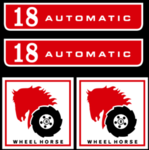-
Similar Content
-
 By a.dumont
By a.dumont
Repairing a 1973 Auto 18 with a Kohler twin. Previous owner installed both an aftermarket vacuum operated fuel pump at the engine, and an electric fuel pump below the tank...(why? Who knows.) First, does anyone know what type of pump was original to this engine? Where was it located? (Pictures appreciated.) Second, can an electric pump rated at 1-4 psi be used? (Don't want so much pressure that it unseats the needle in the carb and floods the engine.)
-

